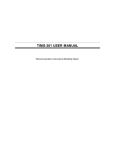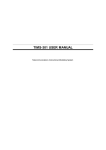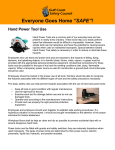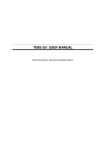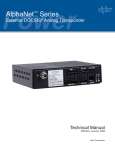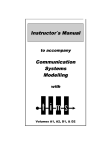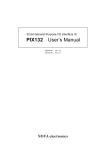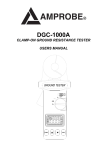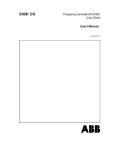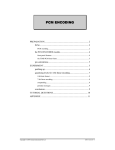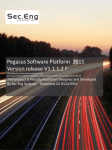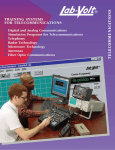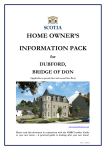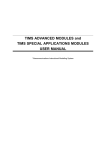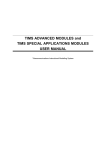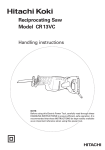Download Specifications
Transcript
TIMS-801 JUNIOR USER MANUAL Telecommunications Instructional Modelling System TIMS-801 JUNIOR USER MANUAL Issue Number 1.1 October 2001 Published by: EMONA INSTRUMENTS PTY LTD a.c.n. 001 728 276 86 Parramatta Road Camperdown NSW 2050 Sydney AUSTRALIA COPYRIGHT c 2001 by EMONA INSTRUMENTS PTY LTD TIMS is a registered trademark of AMBERLEY HOLDINGS PTY LTD Printed in Australia CONTENTS Part I TIMS INTRODUCTION TIMS OVERVIEW SYSTEM CONVENTIONS Front Panel Sockets Plug-in Modules Labeling Basic Modules List Basic Specifications Part II BASIC MODULES USER INSTRUCTIONS Adder Audio Oscillator Buffer Amplifiers Dual Analog Switch Frequency and Event Counter Master Signals Multiplier Phase Shifter Quadrature Phase Splitter Sequence Generator Tuneable LPF Twin Pulse Generator Utilities Module Variable DC Voltage Controlled Oscillator 60kHz Lowpass Filter 1 2 3 4 5 6 7 8 9 11 12 14 15 17 18 20 22 23 25 TIMS INTRODUCTION TIMS OVERVIEW TIMS is a telecommunications modelling system. It models mathematical equations representing electrical signals, or block diagrams representing telecommunications systems. TIMS is primarily a hands-on rather than demonstration style teaching system, which combines both the theoretical and practical aspects of implementing systems. We are confident that TIMS will provide the student with a clearer understanding of the concepts behind telecommunications theory. Physically, the TIMS-801 JUNIOR is a compact, single rack system. The rack accepts up to 8 Eurocard sized, compatible "telecommunications building blocks", or modules. It also contains 4 fixed modules, as well as the system power supply. The modules are very simple electronic circuits, which function as basic communications building blocks. Each module, fixed or plug-in, has a specific function; functions fall into four general categories: Signal Generation - oscillators, etc Signal Processing - multipliers, filters, etc Signal Measurement - frequency counter Digital Signal Processing - TMS320C50 based Modules are patched together via the front panel sockets using interconnecting leads, to model the system under investigation. TIMS-801 Junior User Manual 1 SYSTEM CONVENTIONS All TIMS modules conform to the following mechanical and electrical conventions. A - FRONT PANEL SOCKETS Signal interconnections are made via front panel, 4mm sockets Sockets on the LEFT HAND SIDE are for signal INPUTS. All inputs are high impedance, typically 56k ohms. Sockets on the RIGHT HAND SIDE are for signal OUTPUTS. All outputs are low impedance, typically 330 ohms. YELLOW sockets are only for ANALOG signals. ANALOG signals are held near the TIMS standard reference level of 4V pk-pk. RED sockets are only for DIGITAL signals. DIGITAL signals are TTL level, 0 to 5 V. GREEN sockets are all common, or system GROUND. Note that input and output impedances are intentionally mismatched, so that signal connections may be made or broken without changing signal amplitudes at module outputs. B - PLUG-IN MODULES Any plug-in module may be placed in any of the 12 positions of the upper rack. All modules use the back plane bus to obtain power supply : only the DSP modules (not part of the BASIC SYSTEM) use the bus to transfer signals. The modules are designed so that they may be pluggedin or removed at any time, without turning off the system power. The modules are not locked into position and may need to be held while interconnecting leads are removed. C - LABELING All modules are identified as to the function they perform. Inputs, outputs, controls and switches are labeled so that a student who has had only a brief introduction to TIMS can use the modules without needlessly referring back to this USER MANUAL. It should be noted that no variable controls have calibration marks. This is intentional, as the philosophy behind TIMS is that students setup and adjust systems by observing and measuring signals. This assists the student in gaining a much greater understanding, feel and insight into the operation of a communications implementation. TIMS-801 Junior User Manual 2 D - BASIC MODULE LIST Below are listed all the fixed, TIMS-801 JUNIOR SYSTEM MODULES and the optional plug-in BASIC modules. TIMS-801 JUNIOR SYSTEM FIXED MODULES Buffer Amplifiers Frequency and Event Counter Master Signals Variable DC OPTIONAL BASIC PLUG-IN MODULES Adder Audio Oscillator Dual Analog Switch Multiplier Phase Shifter Quadrature Phase Splitter Sequence Generator Tuneable LPF Twin Pulse Generator Utilities Module Voltage Controlled Oscillator 60kHz Lowpass Filter BASIC SPECIFICATIONS POWER SUPPLY Input 110, 127, 220 or 240V AC, 47Hz to 63Hz Output +15V, 1.25A DC -15V, 1.25A DC Protection short circuit, overload, thermal Regulation 0.2% PHYSICAL Case Dimensions 490(W) x 330(D) x 310(H) mm System Weight 10kg Plug-in Card Dimensions 160 x 100 mm Plug-in Card Bus Connectors 64 way, 2 row, Eurocard MODULES Specifications for each module are listed in the following pages. TIMS-801 Junior User Manual 3 ADDER OPTIONAL BASIC PLUG-IN MODULE Two analog input signals A(t) and B(t) may be added together, in adjustable proportions G and g. The resulting sum is presented at the output. G:GAIN CONTROL FOR INPUT A ANALOG INPUT g:GAIN CONTROL FOR INPUT B ANALOG OUTPUT ANALOG INPUT FRONT PANEL BLOCK DIAGRAM USE Care must be taken when adjusting the gains to avoid overloading the following modules. Overloading will not cause any damage but it means non-linear operation, which is to be avoided in analog systems. The ADDER is capable of delivering a signal well in excess of the standard reference level, 4V pk-pk, given a standard level input. The ADDER can also be used as a normal amplifier by using only one input and turning the gain of the other input to minimum. It is not necessary to ground the unused input. Note that gains G and g are negative. All inputs and outputs are DC coupled. BASIC SPECIFICATIONS Gain Range 0 < G < 2; 0 < g < 2; Bandwidth approx. 1MHz Output DC Offset <10mV, open circuit inputs PARAMETERS TO NOTE maximum output level; linearity; polarity inverting; phase shift TIMS-801 Junior User Manual 4 AUDIO OSCILLATOR OPTIONAL BASIC PLUG-IN MODULE The AUDIO OSCILLATOR is a low distortion tuneable frequency sinewave source with a frequency range from 500Hz to 10kHz. Three outputs are provided. Two outputs are sinusoidal, with their signals in quadrature. The third output is a digital TTL level signal. INPHASE ANALOG OUTPUT SYNCHRONIZE INPUT FREQUENCY ADJUST TTL LEVEL OUTPUT QUADRATURE ANALOG OUTPUT FRONT PANEL BLOCK DIAGRAM USE The frequency of each of the three outputs is the same and is varied by the front panel ∆ f control. Both the in-phase and quadrature analog output signals have fixed amplitude. Their shape is sinusoidal, having a distortion of less than 0.1%. The AUDIO OSCILLATOR may be synchronized to an external periodic signal by connecting such a signal to the front panel SYNC input. A signal of about 1 volt peak is adequate for this purpose. For synchronization to be achieved, the AUDIO OSCILLATOR must be manually tuned to within a few percent of the frequency to which synchronization is desired. BASIC SPECIFICATIONS Frequency Range 300Hz to 10kHz Analog Output Level 4V pk-pk Distortion <0.1% analog outputs only Digital Output TTL level PARAMETERS TO NOTE frequency range; relative phase of outputs; amplitude stability with frequency range; harmonic content; short term stability; synchronizing characteristic. TIMS-801 Junior User Manual 5 BUFFER AMPLIFIERS TIMS-801 JUNIOR FIXED SYSTEM MODULE Two independent variable gain amplifiers are provided. GAIN CONTROL ANALOG INPUT OF FIRST AMPLIFIER ANALOG OUTPUT GAIN CONTROL ANALOG INPUT OF SECOND AMPLIFIER ANALOG OUTPUT FRONT PANEL BLOCK DIAGRAM USE These buffers may be used to amplify small signals or attenuate large signals. Each amplifier has its own gain control on the front panel. Care should be taken to ensure that later modules are not overloaded due to excessive gain. Overload will not cause any damage but it means non-linear operation, which is to be avoided in analog systems. If overload occurs, turn the gain control counter clockwise. BASIC SPECIFICATIONS Bandwidth DC to approx. 1MHz Gain 0 to 10 TIMS-801 Junior User Manual 6 DUAL ANALOG SWITCH OPTIONAL BASIC PLUG-IN MODULE Two identical analog switches are controlled by digital, TTL level signals. The outputs of the two switches are added internally and presented at the output of the module. ANALOG INPUT 1 TTL CONTROL FOR INPUT 1 TTL CONTROL FOR INPUT 2 ANALOG INPUT 2 OUTPUT FRONT PANEL BLOCK DIAGRAM USE Each switch may be closed independently by a TTL HIGH at the respective control input. The switch outputs are combined internally and are presented at the common output socket. Open circuit voltage gain between each input and the module output is unity when the switch is closed. BASIC SPECIFICATIONS Analog Input Bandwidth >300kHz Maximum CONTROL clock > 100kHz CONTROL Input Levels TTL only Maximum Analog Input Level +8V PARAMETERS TO NOTE switch On/Off ratio; linearity; switching speed; analog bandwidth; channel cross talk; DC off-set TIMS-801 Junior User Manual 7 FREQUENCY COUNTER TIMS-801 JUNIOR FIXED SYSTEM MODULE The TIMS-801 JUNIOR’s counter is a 5 digit, 99.999kHz frequency and event counter. 1 6 2 5 3 4 BASIC SPECIFICATIONS 1 OVERflow indication LED 2 ANALOG/TTL input: Bandwidth 40Hz to greater than 100 kHz Sensitivity 250mV typically, @ 100kHz Maximum input +12V 3 TTL ENABLE may be used to gate the TTL input signal. Specifications are same as for the main input. 4 Mode selection switch kHz : Frequency counter mode Gate time of 1s with reading in kHz COUNTS : Event counter mode displays number of pulses counted since last RESET 5 RESET Push Button resets the count of the Event Counter to zero 6 5 digit, 7 segment display of frequency or pulse counts; maximum display 99999 ADVANCED FREQUENCY COUNTER INFORMATION In frequency counter mode this module can be used, along with an oscilloscope, to accurately measure the frequency of signals between 100kHz and 900kHz. If a signal of more than 100kHz is input, then the OVERFLOW LED will be lit. However the 5 digit display will always accurately display the 5 least significant digits of the measurement. So if an oscilloscope is used to determine the frequency of the unknown signal to the nearest 100kHz, this module’s 5 digit display will measure the lower 5 significant digits of the frequency measurement. TIMS-801 Junior User Manual 8 MASTER SIGNALS TIMS-801 JUNIOR FIXED SYSTEM MODULE Five synchronized analog and digital signals are available, ranging from 2kHz to 100kHz. The function and frequency of each signal is indicated on the front panel. QUADRATURE ANALOG CARRIER SIGNAL INPHASE ANALOG CARRIER SIGNAL TTL LEVEL CARRIER SIGNAL TTL LEVEL ANALOG SIGNAL FRONT PANEL BLOCK DIAGRAM USE Signals are labeled as follows: CARRIER signals are 100kHz, which for modelling purposes is sufficiently far from the audio channel bandwidth of 3kHz. The SAMPLE CLOCK of 8.3kHz, which may be used to sample bandwidth-limited (3kHz) audio message signals. MESSAGE provides an audio frequency signal which is synchronized to a sub-multiple of the carrier to enable ’text-book’ like displays of simple modulation schemes to be achieved. The five signals are derived from a master crystal oscillator resulting in low frequency drift. Their frequencies are fixed internally. The output levels are also fixed. To vary the amplitude, the signals may be applied to the neighboring buffers. The analog signals are sinusoidal in shape, having a distortion of less than 0.1%. Digital signals are all standard TTL level, with rise times of better than 80nsec. TIMS-801 Junior User Manual 9 BASIC SPECIFICATIONS Output Frequencies 100kHz, carrier 8.333kHz, sample clock 2.083kHz, audio (carrier sub-multiple) Output Levels 4V pk-pk, analog TTL level, digital Distortion <0.1%, analog outputs only PARAMETERS TO NOTE short term frequency stability; relative phase of quadrature outputs; harmonic content. TIMS-801 Junior User Manual 10 MULTIPLIER OPTIONAL BASIC PLUG-IN MODULE Two analog input signals X(t) and Y(t) may be multiplied together. The resulting product is scaled by a factor of approximately 1/2 so that, with standard level inputs, later stages are not overloaded. INPUT COUPLING SWITCH ANALOG INPUT ANALOG OUTPUT ANALOG INPUT FRONT PANEL BLOCK DIAGRAM USE The input coupling switch may be used to remove input DC components by switching to AC coupling. It should be noted that any DC component in the output will not be removed. The "k" factor (a scaling parameter associated with "four quadrant" multipliers) is approximately one half. It is defined with respect to the OUTPUT from the module and may be measured experimentally. BASIC SPECIFICATIONS Bandwidth approx. 1MHz Characteristic k.X(t).Y(t) k approx. 1/2 PARAMETERS TO NOTE linearity; k factor; carrier leak; phase response; DC off-set; performance as a squarer; frequency response; "conversion gain" as a (de)modulator. TIMS-801 Junior User Manual 11 PHASE SHIFTER OPTIONAL BASIC PLUG-IN MODULE The PHASE SHIFTER introduces a phase shift between its input and output. This phase shift is adjustable by the user. The frequency range of operation can be selected by PCB mounted switch. BLOCK DIAGRAM COARSE PHASE ADJUST FINE PHASE ADJUST 180O PHASE CHANGE ANALOG INPUT ANALOG OUTPUT FRONT PANEL PCB VIEW USE This variable PHASE SHIFTER is capable of varying the magnitude of the phase shift through 360 degrees in two steps. The 180 degree switch selects the step or region of interest; the COARSE and FINE controls are used to then obtain the required phase shift, Φ. If the input is COS(µt), then the output is COS(µt- Φ), where Φ lies between 0 and 180 degrees. Although the PHASE SHIFTER will operate from a few hertz up to 1MHz it has been optimized to operate in the neighborhood of two frequencies: around 100kHz in the HI range and around 2kHz in the LO range. A PCB mounted switch is used to select the frequency range. The open circuit gain through the PHASE SHIFTER is essentially unity for all phases, but note that the amount of phase shift, Φ, is a function of frequency. This is NOT a wideband phase changer: thus all the frequency components of a complex signal’s spectra are not shifted by the same phase. TIMS-801 Junior User Manual 12 BASIC SPECIFICATIONS Bandwidth <1MHz Frequency Range HI approx. 100kHz * LO approx. 2kHz * * For 0 to 360 degree range of phase shift. The phase shift range increases (i.e. resolution decreases) as the input frequency increases. Coarse approx. 180 degrees shift Fine approx. 20 degrees shift PARAMETERS TO NOTE Variation of phase change with frequency change. TIMS-801 Junior User Manual 13 QUADRATURE PHASE SPLITTER OPTIONAL BASIC PLUG-IN MODULE When the same analog signal is applied to both inputs, the two output signals will differ in phase by 90 degrees. The phase splitter networks are wideband, typically covering the range from 200Hz to 10kHz. ANALOG INPUT TO NETWORK 1 ANALOG OUTPUT FROM NETWORK 1 ANALOG INPUT TO NETWORK 2 ANALOG OUTPUT FROM NETWORK 2 FRONT PANEL BLOCK DIAGRAM USE The QUADRATURE PHASE SPLITTER consists of two wideband phase shifting networks. The networks’ phase responses vary with frequency in a complimentary manner, giving a 90 degree phase difference between the outputs, over a wide frequency range. In communications the most important application is the generation and demodulation of Single Sideband by the "phasing method". BASIC SPECIFICATIONS Frequency Range 200Hz to 10kHz typically Phase Response 90 degrees between outputs, given the same input signal to both networks. PARAMETERS TO NOTE Phase error from 90 degrees. This may be measured directly (difficult !) or calculated from sideband suppression measurements. TIMS-801 Junior User Manual 14 SEQUENCE GENERATOR OPTIONAL BASIC PLUG-IN MODULE (PSEUDORANDOM SEQUENCE GENERATOR) Using a common external clock signal, the sequence generator outputs two independent pseudorandom sequences X and Y. A SYNC output is provided which is coincident with the start of the sequences. The sequences may be stopped and restarted at any time via front panel controls. Sequences X and Y are available as either standard TTL or analog level output. RESET PUSH BUTTON ANALOG OUTPUT TTL LEVEL RESET ANALOG OUTPUT BEGINNING OF SEQUENCE SYNC ANALOG CLOCK TTL OUTPUT TTL CLOCK TTL OUTPUT FRONT PANEL BLOCK DIAGRAM USE An external clock signal must be provided to operate the SEQUENCE GENERATOR. This may be sinusoidal or TTL: separate input sockets are used. The sequences may be stopped at any time by either depressing the RESET button or applying a TTL HI signal to the RESET input. To restart the sequences from the beginning, release the RESET button or apply a TTL LO to the RESET input. The length of the sequences may be selected by a PCB mounted dip switch. Four independent sequence pairs are available from lengths of 25 to 211. The sequences are selected as follows: DIP SWITCH CODE n SEQUENCE LENGTH 2n msb 0 0 5 32 0 1 8 256 1 0 8 256 1 1 11 2048 TIMS-801 Junior User Manual 15 BASIC SPECIFICATIONS Input Clock Range TTL 1Hz to 1MHz Analog <500Hz to >10kHz Number of Sequences 4 pairs Sequence Lengths 25, 28, 28, 211 Sync indicates start of sequence PARAMETERS TO NOTE sequence distribution; noise generation using pseudorandom sequences. TIMS-801 Junior User Manual 16 TUNEABLE LPF OPTIONAL BASIC PLUG-IN MODULE The cutoff frequency of this LOWPASS FILTER can be varied using the TUNE control. Two frequency ranges, WIDE (2.0kHz to 12kHz) and NORMAL (900Hz to 5kHz), can be selected by a front panel switch. The GAIN control allows input signals to be attenuated if required. CLK/880 = f-3dB; NORMAL CLK/360 = f-3dB; WIDE CUT-OFF FREQUENCY ADJUST GAIN ADJUST FREQUENCY RANGE SELECT ANALOG OUTPUT ANALOG INPUT FRONT PANEL BLOCK DIAGRAM USE This lowpass filter has a 7th order elliptic filter characteristic. The stopband attenuation is typically 50dB and passband ripple is approximately 0.5dB. The GAIN control should be used to attenuate large input signals and thus avoid saturation of the filter output circuits. Two frequency ranges are provided. NORMAL range provides more precise control over the lower audio band, used for telecommunications message channels. The WIDE range expands the filter’s range to above 10kHz. The CLK output provides an indication of the filter’s cutoff frequency. Note that above 9kHz the dividing factor increases from 340 to 430 at 12kHz. BASIC SPECIFICATIONS Filter Ranges 900Hz < NORMAL < 5 kHz and 2.0kHz < WIDE < 12 kHz, continuously variable over each range. Stopband Attenuation > 50dB Passband Ripple < 0.5dB PARAMETERS TO NOTE corner point; phase shift; gain range; passband ripple; out of band attenuation. TIMS-801 Junior User Manual 17 TWIN PULSE GENERATOR OPTIONAL BASIC PLUG-IN MODULE (TWIN PULSE GENERATOR - VERSION 2.0) A positive going edge applied at the CLOCK input causes a positive pulse to occur at the output terminals. There are two operating modes: TWIN and SINGLE. Only TWIN mode is limited to low frequency CLOCK inputs. In TWIN mode, Q1 outputs the leading pulse and Q2 outputs the delayed pulse. The time between pulses Q1 and Q2 can be varied, as can the pulses’ widths. In SINGLE mode, only Q1 outputs a positive going pulse, while Q2 outputs the inverse of Q1. The pulse width can be varied. ERROR LED, INDICATES IF 2tW + tD > tCLK BLOCK DIAGRAM PULSE WIDTH CONTROL DELAYED PULSE OUTPUT: TTL LEVEL LEADING PULSE OUTPUT: AC COUPLED DELAY TIME CONTROL DIGITAL CLOCK TTL LEVEL OUT FRONT PANEL TIMING DIAGRAM USE A digital TTL level signal is applied to the CLK input. The GENERATOR then outputs one or two pulses, depending upon the operating mode selected. Use the PCB mounted MODE switch to select either SINGLE or TWIN operating mode. TWIN MODE TWIN mode is used when two sequential pulses are needed. Two equal width positive pulses occur as a result of each CLK signal positive edge. Pulse Q1 always occurs before pulse Q2. The width of both pulses is controlled by the front panel WIDTH control. The DELAY control varies the spacing between the two pulses. Note that TWIN mode will only accept CLOCK input signals of up to 50kHz, depending upon front panel settings. If WIDTH and DELAY have been incorrectly set, causing anomalous operation, the ERROR LED will be lit. To eliminate the error reduce DELAY and then WIDTH - by turning counter clockwise. TIMS-801 Junior User Manual 18 SINGLE MODE SINGLE mode is used to obtain a train of equal width pulses from any TTL level signal. Equal width positive pulses occur at Q1 output as a result of each CLK signal positive edge. The width of the pulses is controlled by the front panel WIDTH control. Q2 simultaneously outputs the compliment of Q1. The DELAY control is not used in this mode. Note that Q1 includes both a TTL level and an AC coupled output pulse. BASIC SPECIFICATIONS TWIN MODE Clock Frequency Range < 50kHz Pulse WIDTH 3µs < tw < 25µs Pulse DELAY Q2-Q1 10µs < td < 120µs Error Indication 2tw + td > tCLK SINGLE MODE Clock Frequency Range < 200kHz Pulse WIDTH 3µs < tw < 25µs TIMS-801 Junior User Manual 19 UTILITIES MODULE OPTIONAL BASIC PLUG-IN MODULE The Utilities Module houses 4 independent functional blocks: (i) A signal COMPARATOR with TTL output and CLIPPER with bipolar output, for squaring analog waveforms. The COMPARATOR’s threshold level may be set as required by applying a DC voltage to the REF input. The CLIPPER’s gain may be set by adjusting DIP switches SW1 and SW2. (ii) Precision halfwave RECTIFIER. (iii) Simple diode and single pole, audio range, RC Lowpass Filter. (iv) Single pole, audio range, RC Lowpass Filter. CLIPPER BIPOLAR OUTPUT ANALOG REFERENCE INPUT ANALOG SIGNAL INPUT COMPARATOR TTL OUTPUT ANALOG INPUT ANALOG OUTPUT ANALOG INPUT ANALOG OUTPUT ANALOG INPUT ANALOG OUTPUT FRONT PANEL BLOCK DIAGRAM USE COMPARATOR The COMPARATOR will square any analog signal and provide a standard TTL level output. The switching threshold level is determined by the voltage level applied to the REF input. NOTE: For correct COMPARATOR operation, the REF input must never be left unconnected. The REF input may be connected to GROUND, VARIABLE DC or any other signal source. CLIPPER The CLIPPER will amplify any analog TIMS level signal and then clip the amplitude of the amplified signal, to a fixed level of approximately +1.8V. The clipping action is performed by standard small signal diodes. NOTE: The REF input is NOT used by the CLIPPER. TIMS-801 Junior User Manual 20 Adjusting the gain of the CLIPPER, determines whether the clipping action is "SOFT", "MEDIUM" or "HARD". The following table, UTIL-1, relates DIP switch settings to CLIPPER gains and clipping action, CLIPPING ACTION GAIN DIP SWITCH SETTINGS (approx.) SW1 (both a & b) SW2 (both a & b) SOFT x0.8 ON - ON OFF - OFF MEDIUM x8 OFF - OFF OFF - OFF HARD x40 OFF - OFF ON - ON - not applicable ON - ON ON - ON Table UTIL-1: CLIPPER gain settings DIP switches SW1 and SW2 will be found in the middle of the UTILITIES module’s circuit board. NOTE: Both halves (bits) of each switch must be in the SAME position at all times. BASIC SPECIFICATIONS COMPARATOR Operating Range > 500kHz TTL Output Risetime 100nsec (typ) CLIPPER Operating Range > 500kHz Output Level 1.8Vpk (typ) Adjustable Gains 3 steps; x0.8, x8 and x40 (approx.) RECTIFIER Bandwidth DC to 500kHz (approx.) DIODE & LPF LPF -3dB 2.8kHz (approx.) RC LPF LPF -3dB 2.8kHz (approx.) TIMS-801 Junior User Manual 21 VARIABLE DC TIMS-801 JUNIOR FIXED SYSTEM MODULE The VARIABLE DC module is a stable, bipolar DC source and a fixed +5V output. +5V DC VOLTAGE CONTROL DC OUTPUT GROUND REFERENCE FRONT PANEL BLOCK DIAGRAM USE The DC voltage output varies from about -2.5V when the control is fully counter clockwise through zero to +2.5V when control is turned fully clockwise. If greater resolution or wider range is required, then one of the BUFFER AMPLIFIERS can be used in conjunction with the VARIABLE DC module. The fixed output provides a TTL level logical HI, +5V. BASIC SPECIFICATIONS Voltage Range +2.5V DC Short-term Stability < 2mV/hr Resolution approx. 20mV Output Current < 5mA Fixed Output +5V DC Output Current approx. 15mA TIMS-801 Junior User Manual 22 VCO OPTIONAL BASIC PLUG-IN MODULE The Voltage Controlled Oscillator module functions in two modes: either as a VOLTAGE CONTROLLED OSCILLATOR with analog input voltage or as an FSK GENERATOR with digital input. Both modes have two frequency ranges of operation which are selected by a range switch. The VCO frequency and input sensitivity can be controlled from the front panel. FSK DATA INPUT - TTL LEVEL TTL LEVEL OUTPUT SET SENSITIVITY OF INPUT CONTROL VOLTAGE Vin OVERLOAD INDICATION LED SET CENTER FREQUENCY BLOCK DIAGRAM FREQUENCY RANGE SELECCONTROL VOLTAGE INPUT ANALOG OUTPUT FRONT PANEL PCB VIEW VCO USE STANDARD VCO OPERATION The VCO output frequency is controlled by an analog input voltage. The input voltage, Vin, is scaled - amplified - by the front panel GAIN control. A DC voltage can be added to Vin internally, thus setting the start or CENTER FREQUENCY, fo . The CENTER FREQUENCY is defined as the VCO output frequency, when no voltage is applied to the Vin connector. The Vin input is internally tied to ground if no signal is applied. The Vin OVERLOAD LED is lit when the sum of these voltages - scaled Vin plus CENTER FREQUENCY DC offset - exceed the oscillator’s internal operating limits. Decrease the GAIN turn counter clockwise - and/or shift the CENTER FREQUENCY, fo , to extinguish the LED. The frequency range switch selects between the HI or carrier band and the LO or audio band. Both sinewave and digital outputs are available. TIMS-801 Junior User Manual 23 SPECIAL VCO OPERATION - FINE FREQUENCY CONTROL In some applications, fine control may be required over the output frequency of the VCO. This may be easily achieved by following these four steps: MODULES REQUIRED: VCO and VARIABLE DC. STEP 1 - Set the VARIABLE DC module’s output close to zero (marker knob at 12 o’clock position). STEP 2.1 - Turn the GAIN control of the VCO to zero, fully counter-clockwise. STEP 2.2 - Now, turn the GAIN control up, clockwise, just a little (only a few degrees). STEP 3 - Set the VCO module’s output frequency as close as possible to the frequency of interest. Use the frequency adjust knob, fo. Use the FREQUENCY COUNTER to measure the VCO’s output frequency. STEP 4 - Finally, patch the VARIABLE DC module’s output to the VCO module’s frequency control input, Vin, with a standard patching lead. FINE FREQUENCY CONTROL of the VCO module is now achieved by turning the VARIABLE DC module’s voltage control knob. FSK USE A PCB mounted slide switch selects between FSK and VCO modes of operation. The two output frequencies, FSK1 and FSK2 , (MARK and SPACE), are set by varying the PCB mounted, finger adjustable trimmers. As in VCO mode, the frequency range switch selects between the HI or carrier band and the LO or audio band. The digital data input accepts only TTL level signals. Both sinewave and digital outputs are available. GAIN and CENTER FREQ, fo , controls and the Vin connector are not used in the FSK mode. BASIC SPECIFICATIONS VCO MODE Frequency Ranges 1.5kHz < LO < 17kHz; sinewave and TTL ( <300Hz with external input voltage, Vin ) 70kHz < HI < 130kHz; sinewave and TTL Input Voltage -3V < Vin < 3V Overload limit indication LED Vvco > + 3V; Vvco is the internal voltage finally applied to the VCO circuitry. GAIN G.Vin : 1 < G < 2 Center Frequency Voltage Range - 3V < Vfc < 3V; Vfc is a DC voltage added INTERNALLY to G.Vin FSK MODE Frequency Ranges 1.5kHz < FSK1, LO < 9kHz 500Hz < FSK2, LO < 4kHz 80kHz < FSK1, HI < 200kHz 20kHz < FSK2, HI < 120kHz Data Input TTL level message TIMS-801 Junior User Manual 24 60kHz LOWPASS FILTER OPTIONAL BASIC PLUG-IN MODULE An elliptic lowpass filter is provided with a cutoff point of approximately 60kHz. The input signal amplitude can be adjusted with the gain control. INPUT GAIN CONTROL ANALOG OUTPUT ANALOG INPUT FRONT PANEL BLOCK DIAGRAM USE The 60kHz LPF allows carrier signals to be removed from a given signal spectrum. For example, as the lowpass filter for envelope detector applications. The GAIN control allows input signals to be attenuated, to avoid overloading the filter. BASIC SPECIFICATIONS Cutoff Frequency approx. 60kHz Passband Gain variable, 0 to 5 (approx.) Stopband Attenuation 50dB (typ) Passband Ripple 0.1dB (typ) PARAMETERS TO NOTE corner point; response shape; passband ripple; phase shift; out of band attenuation. TIMS-801 Junior User Manual 25




























